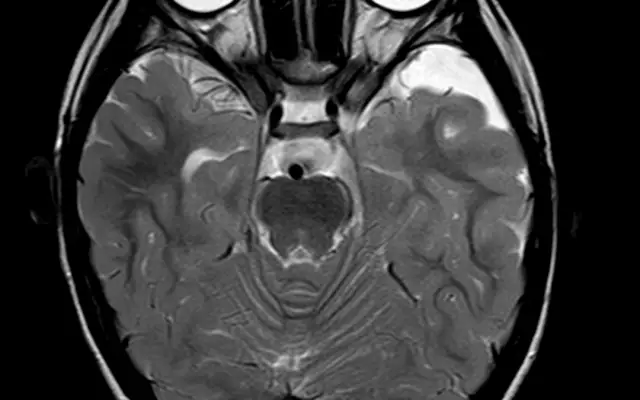- Author Rachel Wainwright [email protected].
- Public 2024-01-15 19:51.
- Last modified 2025-11-02 20:14.
Prostate cyst
The content of the article:
- Causes and risk factors
-
Classification of cystic lesions of the prostate
- Congenital
- Acquired
- Signs of a prostate cyst
- What is the danger for men
- Diagnostics
-
Prostate cyst treatment
- Deleting
- General recommendations
- Video
A prostate cyst is an encapsulated, fluid-filled cavity that is located in the prostate. This pathology, according to statistics, affects every fifth man over the age of 40.

Often a prostate cyst is discovered by chance during an examination for another reason
Causes and risk factors
Congenital cystic formations occur in the presence of certain disorders of intrauterine development. Acquired cysts occur against the background of a number of diseases and adverse effects on the body of the external environment.
The immediate causes of acquired formations are:
- violation of the outflow of secretions produced by the prostate gland;
- excessive production of a secret.
Predisposing factors:
- untreated prostatitis;
- tumors of the prostate gland (benign prostatic hyperplasia);
- irregular sex life;
- too frequent intercourse;
- frequent hypothermia of the body;
- alcohol abuse, smoking;
- excessive physical activity;
- frequent stressful situations, overwork, lack of sleep;
- work related to the impact of vibration on the body;
- improper nutrition;
- genital trauma;
- congestion in the pelvic organs;
- surgical interventions on the prostate gland.
Classification of cystic lesions of the prostate
Cystic formations of the prostate can be congenital and acquired, infectious (including parasitic, which can reach large size) and non-infectious, inflammatory and non-inflammatory, complicated and uncomplicated.
Congenital
Congenital formations are rarely diagnosed and occur when the duct of the gland becomes infected during intrauterine development. This form of pathology is often detected during diagnostics for another reason.
Most often, congenital cystic formations are recorded:
- Müllerian channel;
- prostate uterus;
- seminal vesicle;
- ejaculatory duct.
Acquired
The acquired forms of pathology include:
- multiple small neoplasms with benign cystic prostatic hyperplasia;
- retention cysts that develop during dilatation (expansion) of the lobules of the gland against the background of acquired obstruction of its small ducts. Most often occur in the peripheral part of the gland, can be localized in the area of the internal opening of the urethra.
Signs of a prostate cyst
Small cystic formations that do not compress the urethra (its prostate) usually do not cause any concern to the patient.
With a congenital form of pathology, the patient often turns to the doctor with the onset of active sexual activity, while the only sign may be the detection of blood impurities in the semen. In some cases, hematuria is also noted. Congenital cysts, as a rule, are localized at the base of the gland, have a drop-shaped or fusiform shape. The size of a congenital neoplasm usually does not exceed 4 cm.
If a cystic formation occurs in the area of the inner opening of the urethra, the patient may have difficulty urinating. Symptoms of large cysts are similar in many ways to clinical signs of prostate adenoma.
The main features are presented in the table.
| Clinical sign | Description |
| Urinary disorders | Frequent urge, weakening of the stream, frequent urination at night, the need to strain, burning and pain during the act of urination, feeling of incomplete emptying of the bladder |
| Sexual dysfunction | Weakening of erection, discomfort during ejaculation, premature ejaculation, impotence |
| General deterioration in well-being | Increase in body temperature to subfebrile values, rapid fatigue, pulling pain in the perineum |
What is the danger for men
The condition can be aggravated by:
- accession of the infectious process;
- traumatic ruptures;
- bulging cysts in the rectum;
- overlapping by the formation of the urethra.
Against the background of cystic formations, there can be observed:
- prostatitis;
- stones in the prostate;
- abscess of the prostate;
- atrophy of surrounding tissues;
- deformation of blood vessels located next to the neoplasm;
- acute urinary retention, and a number of other dangerous pathologies.
The consequence of a prostate cyst can be infertility. A purulent cyst can rupture and spread the infection to other organs and tissues.
Diagnostics
On palpation through the rectum, small cysts are usually defined as a dense, round formation. It can be filled with serous or serous-bloody fluid. The content of the cystic cavity can be colorless; when blood gets into it, it becomes brown.
To make a diagnosis, the following are carried out:
- digital rectal examination of the prostate;
- transurethral ultrasound (ultrasound) of the prostate gland;
- CT scan;
To clarify the diagnosis, the following can be carried out:
- laboratory tests of blood, urine, ejaculate, prostate secretion;
- puncture of the neoplasm, followed by laboratory examination of the contents.
In case of urination disorders, uroflowmetry is used.
Prostate cyst treatment
In most cases, treatment is not required, however, the patient is shown dispensary observation in order to control education, his tendency to increase, suppuration, and malignancy. Regular examinations by a doctor are especially important for patients over 40 years old, since in this group of people, the malignant degeneration of a cyst can occur quite quickly and without symptoms.
Deleting
When symptoms appear and the patient's condition worsens, surgical removal of the neoplasm is required. You can remove the cyst using the following methods:
- Puncture of the cavity followed by the introduction of a sclerosing drug into it.
- Laser enucleation of the cyst.
- Surgical intervention is closed (transurethral, transrectal, through the perineum or anterior abdominal wall) or open (laparotomy) method.

Laser enucleation of the prostate cyst
General recommendations
The patient is recommended:
- Proper nutrition (it is recommended to include more vegetables, fruits, herbs in the diet, exclude fatty foods, reduce the consumption of meat and meat products, give up fast food, do not abuse coffee).
- Avoiding physical overload (especially with a full bladder), while maintaining sufficient physical activity in order to eliminate congestion in the small pelvis.
- Regular sex life with a regular partner.
- Rejection of bad habits.
- Avoiding hypothermia.
It is important to promptly treat any diseases of the genitourinary tract, regularly undergo preventive medical examinations.
Video
We offer for viewing a video on the topic of the article.

Anna Aksenova Medical journalist About the author
Education: 2004-2007 "First Kiev Medical College" specialty "Laboratory Diagnostics".
Found a mistake in the text? Select it and press Ctrl + Enter.






